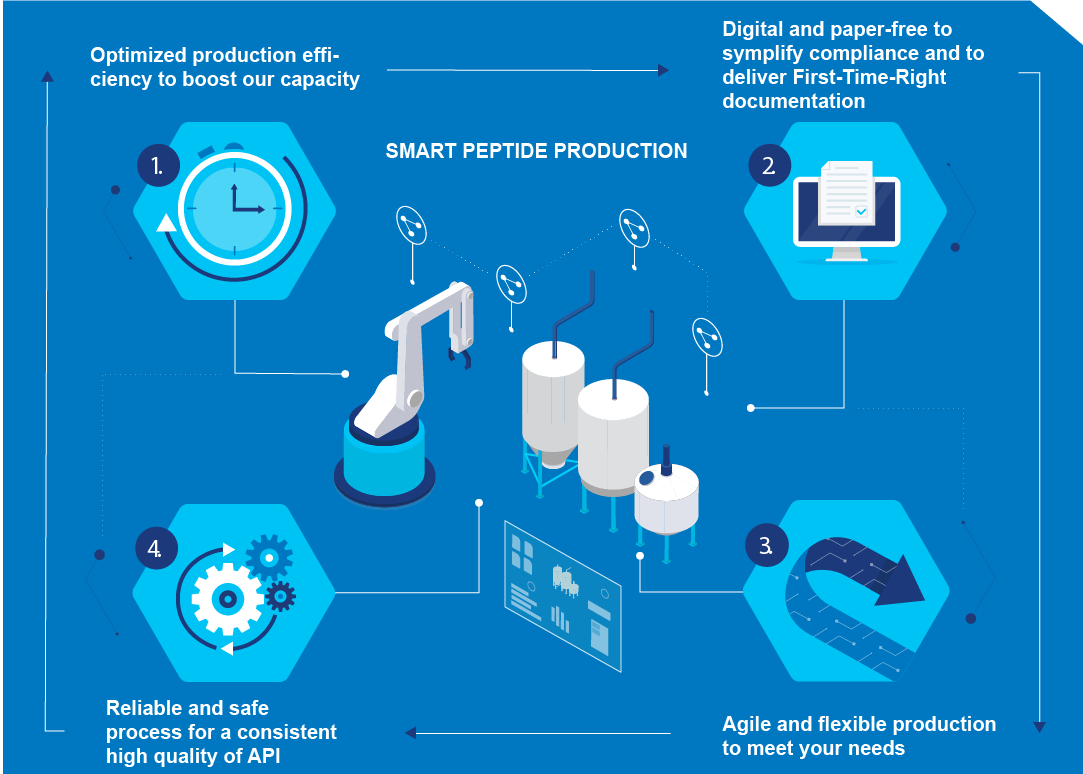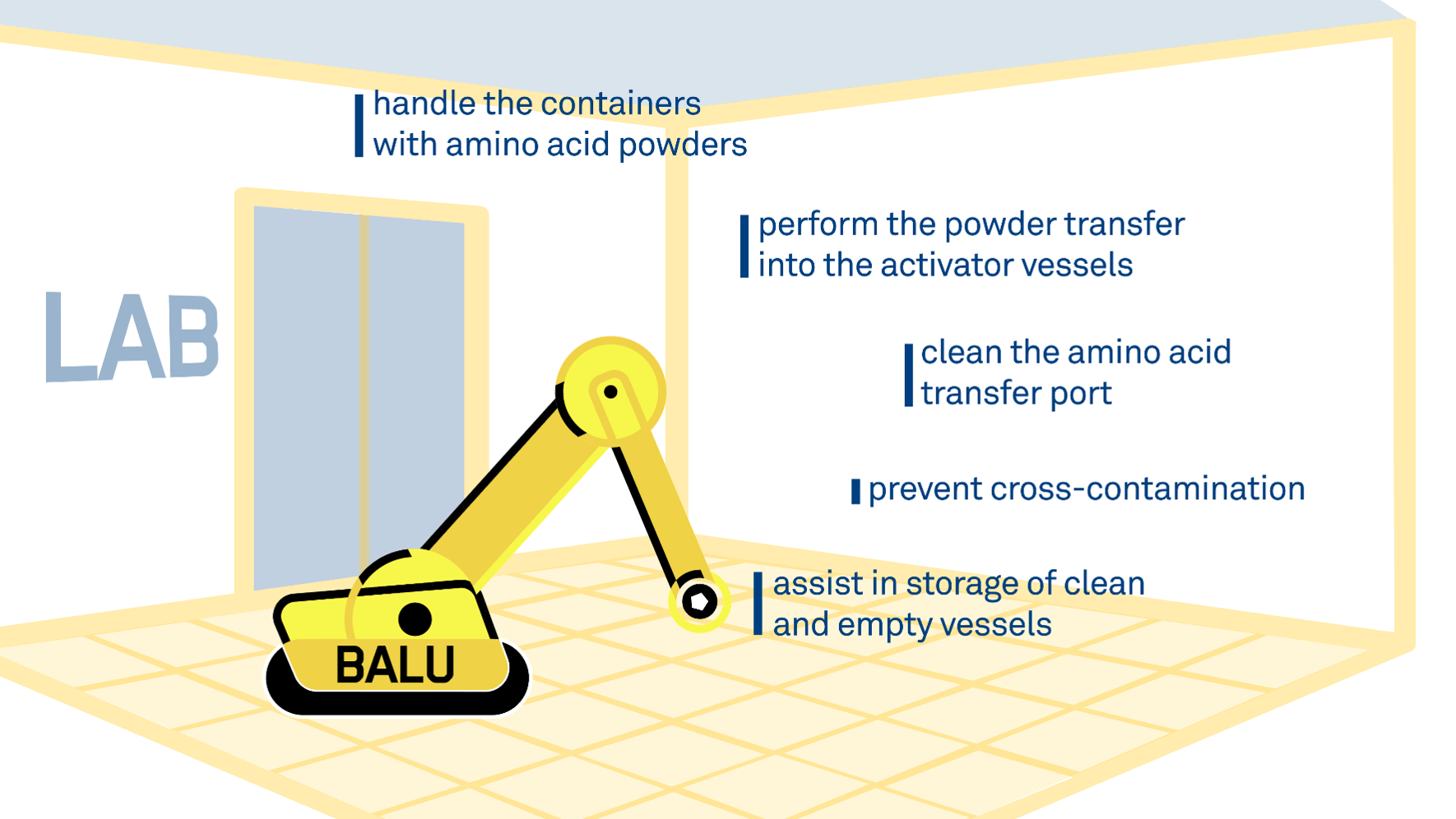Industry 4.0, or the fourth industrial revolution, refers to the automation and digitalization of traditional industrial processes through smart technology and integration. Within this concept, a “smart factory” is characterized by machines which are interconnected, and interoperable, and can process data autonomously. Such “smart factories” require only limited human decision-making or intervention and are therefore sometimes referred to as “intelligent automation.”
Innovation and operational excellence are two important pillars of Bachem’s success. Thus, to keep technological leadership and high-quality services, it was essential to start our digital transformation and to enter the Industry 4.0 area. This will benefit our customers, as we will be able to increase our capacity with a more agile and flexible production, simplify and improve our GMP documentation, and provide a safe, reliable, and scalable manufacturing process delivering consistently high quality API.
Why are we automating and digitalizing SPPS at Bachem?
Optimizing production is crucial to us to help and support our customers in their drug development and manufacturing processes. We have started our journey to Industry 4.0 by automating and digitalizing one of our core business processes, the solid phase peptide synthesis (SPPS) (Figure 1).

Figure 1 – Bachem’s smart production of peptides via SPPS
We have automated our SPPS process so that operations can be carried out with minimal human intervention, thus improving the reliability of the process, reproducibility of results and safety, while significantly increasing the cost-effectiveness of operations. Thanks to automation, we are able to optimize equipment utilization and reduce operating times and personnel time down to a fraction. This reduction enables a higher capacity, efficiency and agility of production and brings more flexibility to take on new projects. Bachem has also invested in digitalization of the production process so that documentation can be conducted in a paper-free way. Furthermore, we can attain improved first-time-right (FTR) rates, data analytics by implementing a plant information (PI) system, and higher data safety and integrity.
Our process innovations
As first steps towards our “smart factory”, we have introduced some major innovations. The first Bachem robot-operator, BALU, was designed and programmed to support commercial scale of SPPS. BALU handles the containers with the amino acid powders and is able to perform the powder transfer into the activator vessels for our 150L SPPS reactors. And the robot does so without the involvement of an operator. BALU can perform other critical tasks, such as cleaning the amino acid transfer port to prevent cross-contamination. A barcode scanner that reads the labels placed on the amino acid containers ensures correct handling.

Figure 2 – Robot’s roles in the SPPS
Another innovative feature of this new fully automated SPPS process is Process Analytical Technology (PAT), which performs inline analytics after key steps. PAT removes the need for manual In-Process Controls (IPC) and provides a better control of Critical Process Parameters (CPP). Additionally, this automated process enables data recording and analytics as well as paper-free cGMP documentation. Implementing PAT to our process control decreases human contributions and cost of goods. Indeed, manual tasks are no longer required and frees resources for other tasks and projects. Furthermore, PAT leads to a higher reproducibility with minimized chemical side reactions. Ultimately, we utilize our assets more efficiently and streamline our production scheduling for a higher capacity and flexibility.
Our digitalization strategy
Our digitalization of the SPPS process was tackled in the following way: the control system of the production floor (Levels 1 and 2 of the Automation Pyramid, see Figure 2) has been integrated with the Manufacturing Execution System (MES, Level 3 in Figure 2). The MES has three critical tasks:
- lead the process control system by defining the sequence of operations that have to be performed (as written in the MES recipe, also called Master Batch Record, MBR)
- record all events, process values, alarms, as they happen during the process, and finally generate the electronic Batch Report, eBR
- manage equipment without the need of physical logbooks.
MES documentation is thus completely paperless while fully GMP compliant!
Full digitalization is reached by connecting the MES to our ERP system, SAP (Level 4 in Figure 2). Executions of process orders, automatic take-out and stock creations, material flow and inventory control are in this way also fully automated and paperless. Finally, our digitalization strategy includes logging in real time and long-term archiving of data on a Historian platform. This PI system allows for real-time and remote monitoring of the factory floor and easy access to data for trending and batch-to-batch comparisons. This provides the basis for future predictive and prescriptive data analytics.

Figure 3 – The automation pyramid
Bachem will embrace a “smart” future together with our customers
Bachem as a CDMO has implemented a new level of automation and digitalization to fulfill the predicted rise in demand of capacity and compliance. We boosted our processes efficiency regarding time, cost, supply and distribution. Entering industry 4.0 and developing our “smart factory” represents a big step forward for our customers in ensuring swifter interaction and more flexibility in manufacturing and in documentation sharing.
Digitalization and automation initiatives are quickly growing, and, in the coming years, thanks to our experiences in SPPS, a growing number of processes will be transformed this way. With these innovations, we keep our technological leadership and set a high industry standard for the best interests of our customers!
Implementation of Industry 4.0 concepts for the manufacturing of “Tides”
Subscribe to our general newsletter
"*" indicates required fields
